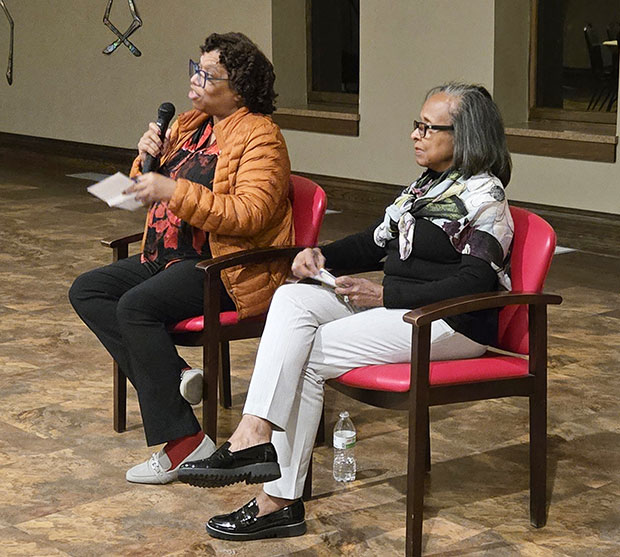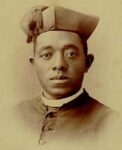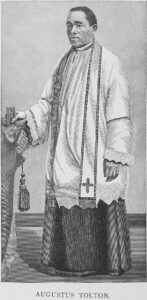
Antoinette Taylor-Thomas, left, and Valerie Jennings, both with the Tolton Spirituality Center in Chicago, talk following a showing of the documentary “Tolton Speaks: The life and letters of Father Augustus Tolton” Oct. 23 at Sacred Heart Cathedral in Davenport.
By Anne Marie Amacher
The Catholic Messenger
DAVENPORT — Although he was born into slavery and denied access to seminaries in the United States because of the color of his skin, Venerable Father Augustus Tolton succeeded and his cause for sainthood continues.
The documentary “Tolton Speaks: The life and letters of Father Augustus Tolton” by Stella Maris Films highlights the life of the first African-American priest to serve in the United States. The St. Martin de Porres Society and Notre Dame Club of the Quad Cities presented the documentary in Sears Diocesan Hall at Sacred Heart Cathedral Oct. 23.
The documentary was the vision of Father A. Gerard Jordan, O.Praem, who worked closely with the sainthood cause of Father Tolton and served as a director of the Tolton Spirituality Center in Chicago, said Valerie Jennings, interim director of the center. Father Jordan and Bishop Joseph Perry, former auxiliary bishop of the Archdiocese of Chicago, primarily tell the story of Father Tolton throughout the documentary. Father Jordan never got to see the final product as he passed away in 2022.
Following the documentary screening, Jennings and Antoinette Taylor-Thomas, associate director of the Tolton Spiritually Center, spoke and answered questions.

Jennings said like Father Jordan’s spirit, the documentary does so much justice and “gets the story told” of Father Tolton. “I believe it will happen (sainthood),” she added.
Kelly Bush, president of the Notre Dame Club of the Quad Cities, said the club began showing documentaries five years ago.
“One of the biggest impressions I came away with (from the film) was the grit of Father Tolton,” Bush said. “He simply did not give up. Slavery, crossing the mighty Mississippi, racism, poverty — he just kept striving toward his goal of serving God’s people. Inspirational, to say the least.”
Tolton was born a slave to the Elliott family in Brush Creek, Missouri, on April 1, 1854. His baptismal record notes he was the “property of Stephen Elliott.”
When Elliott died, there was no will, so his wife began the process of selling the farm and its slaves. Wanting to keep her family together, Tolton’s mother, Martha, escaped with her children during the Civil War. While on the run, the Toltons slept during the day and moved about by night with the goal of reaching Illinois — a free state.
When the family reached Hannibal, Missouri, hired slave catchers caught up with them. Union soldiers helped the family get into a boat. Martha paddled with one oar across the Mississippi River as guns were being fired at her. The family successfully made the crossing and settled in Quincy, Illinois.
Tolton began his education at St. Boniface Catholic School. The religious sisters who taught there helped the future priest learn to read and gave him protection after school from bullying and racism, the documentary stated. But pressure from families with children attending the school led to Tolton being removed.
He then went to work in a tobacco factory at times to support his family and enrolled in a public school. There he was bullied again.
Tolton spent time at the new St. Peter Church in Quincy, and the parish priest inquired about him. The priest talked with Martha Tolton and her son was enrolled in the parish school. After high school, the Franciscan Fathers arranged for him to attend Quincy College. Seeing his devotion, several priests inquired about where Tolton could attend seminary. Time after time admittance of Tolton was rejected due to his race. The Franciscan Friars were then able to get Tolton enrolled in seminary in Rome.
There he learned German, Italian and Latin in addition to his religious studies. On Nov. 8, 1885, Tolton was ordained to the diaconate and on April 24, 1886, to the priesthood at St. John Lateran Basilica in Rome.
The documentary notes that originally, Father Tolton was being prepared to serve in Africa. As a result, he studied different dialects from African countries and learned about the home of his ancestors.
Eventually, Cardinal Giovanni Simeoni overruled Church leaders who wanted to send Father Tolton to serve in Africa and sent him back to Quincy, Illinois.
There the young priest oversaw a Black mission church. His preaching drew white parishioners to his parish — much to the chagrin of others. Tensions grew and repeatedly, Father Tolton requested a transfer out of Quincy. He had offers from other dioceses, including the Archdiocese of Chicago. Finally, in December 1889, Father Tolton began ministry in Chicago. He was still the sole African American Catholic priest in the United States.
His parish celebrated Mass in the basement of the old St. Mary Church. While tending to his growing congregation, Father Tolton accepted invitations to speak across the United States.
Despite being in an impoverished area, a new church for his parish was needed. Father Tolton knew it would take additional money from other sources to build the future St. Monica Church, including donations from the white community. Later, he befriended Mother Katherine Drexel, now a canonized saint, who gave funds from her inheritance to serve Native American and African American ministries. Mother Drexel sent not only money, but also, several years later, religious sisters to teach at nearby St. Elizabeth.
Over time, the busy pastor’s health deteriorated. Then a heatwave in July 1897 hit Chicago. Returning from a priests’ retreat, Father Tolton stepped off a train in 105 degree weather where he collapsed just a short distance later. He was taken to Mercy Hospital, which usually served only whites. He was admitted for treatment. On July 9, 1897, Father Tolton died at the age of 43. Thousands attended his funeral, the documentary noted.
Cardinal Francis George of the Archdiocese of Chicago opened the cause for sainthood for Father Tolton. Bishop Perry was appointed postulator for the cause.
As part of the canonical process, the remains of Father Tolton were exhumed from his grave in Quincy, which is in the Diocese of Springfield, Illinois. He was reburied on site.
On June 11, 2019, Pope Francis declared Father Tolton as venerable. Work continues to find two documented medical miracles for the hopeful beatification, then canonization of Father Tolton.

Father Augustus Tolton, born into slavery, was the first recognized Black American ordained to the priesthood and is a candidate for sainthood.
During a question and answer session after the film, a person in the audience asked what happened to St. Monica Church. Jennings said it eventually merged with St. Elizabeth Church, which is where Mother Drexel’s sisters later taught.
Another attendee asked about Father Tolton’s mother, Martha. Jennings said, “If you think about it, to row a boat with one oar and three kids to cross the river to find the ‘holy land,’ that was a miracle in itself.”
Taylor-Thomas talked about various Black saints or possible future saints, including St. Monica and St. Augustine of Hippo.
Father Tolton could be the first African-American saint from the United States or even North America. She noted he was ordained in Rome. That led to talk of Father Charles Uncles, the first African-American priest to be ordained in the United States physically. She noted James Augustine Healy was the first African-American Catholic priest to become a bishop in the U.S. His brother Patrick Francis Healy, also a priest, became the first African-American president of Georgetown University. Both of the brothers were of mixed-race.
Jennings and Taylor-Thomas travel to show the documentary and have been at several sites since the release this June in Quincy, Taylor-Thomas said. There was also a showing at the National Eucharistic Congress in Indianapolis. Following the recent Davenport visit, the duo headed to Pittsburgh and back to Chicago before taking a break. The documentary showings pick up in February next year beginning at Notre Dame University.
The Notre Dame Club’s first documentary screening was of “Hesburgh” on Father Ted Hesburgh, Notre Dame’s longtime president and head of the Civil Rights Commission during the time of desegregation. The club followed up with The Loyola Project. Then they partnered with the St. Martin de Porres Society at Sacred Heart Cathedral and its president, Thomas Mason IV. Together, the two groups sponsored “A Place at the Table” about the six Black U.S. individuals currently being considered for sainthood, then “Going Home Like a Shooting Star: Thea Bowman’s Journey to Sainthood.”
For more information about how to view “Tolton Speaks,” visit: https://stellamarisfilms.com/








